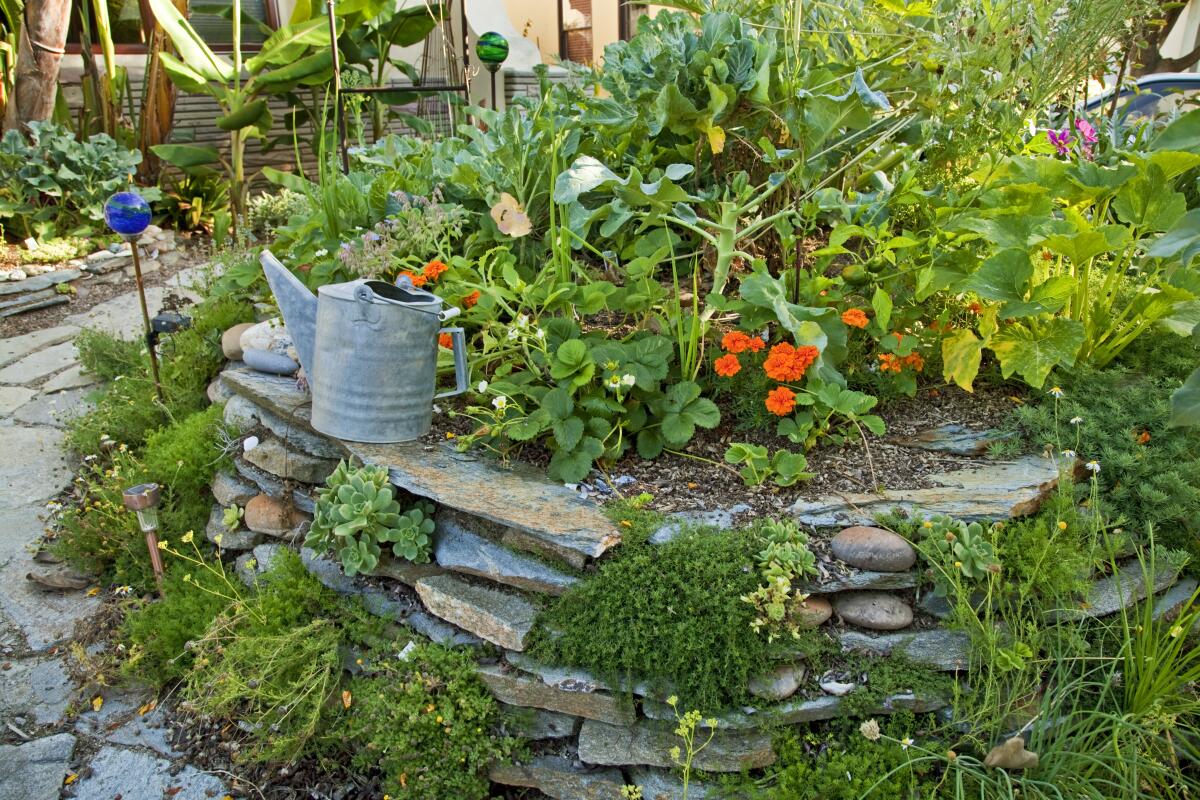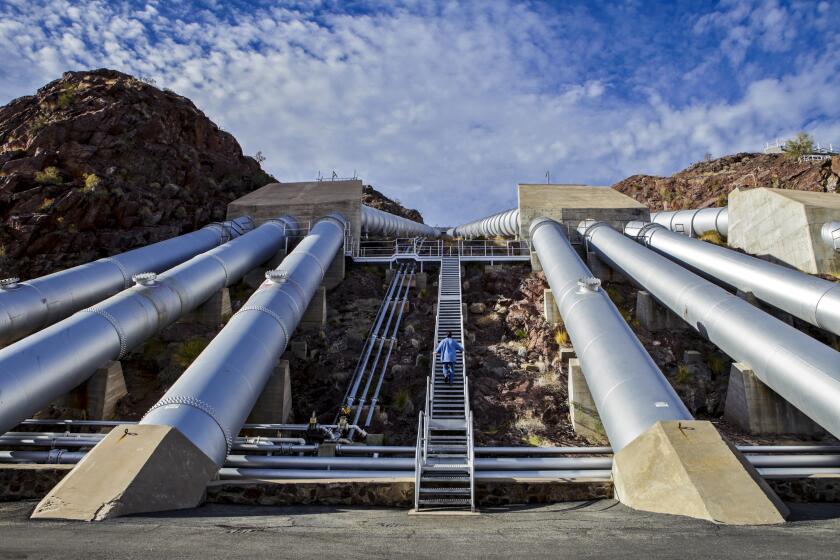Is it virtuous or villainous to grow a garden during a drought?

- Share via
It’s become my New Year’s Day tradition: The morning of every Jan. 1 since sometime in the mid-’90s, I plant a crop of peas. Not like the hard and frosty little emeralds you get by the bag at the supermarket, but sugar snaps and snow peas, which you eat pod and all. The seeds generally go into the ground in my backyard garden in Highland Park just as the Stealth bombers fly overhead to kick off the Rose Parade, a few miles to the northeast.
And then of course I water the seeds and hope that January and February rains will grow tall vines with white or two-tone purple blossoms that turn into beautiful and tasty green and purple pods beginning sometime around St. Patrick’s Day. When the rains don’t come, I use the watering can. Or if there’s one of those increasingly frequent intense winter heat waves, I turn on the faucet and run the hose. And feel guilty.
My pandemic-year garden was lush and productive. Instead of being away all day at work in El Segundo, I was at my desk at home, so I could spend my breaks outside pulling weeds. And watering, just a bit more, when plants that I formerly saw only in early mornings or on weekends seemed a bit droopy.
OK, maybe a lot more. The water bills were enormous.
Of course Southern California didn’t voluntarily conserve water. We were told it was a Northern California problem. But now it’s our problem too.
Among other duties, I write editorials about drought, water shortages and responsible water policy, and I counsel readers to pull out their lawns, so a troubling image formed in my mind. Every time I turned the spigot, I saw Lake Mead’s surface level sink, if ever so slightly.
Lake Mead, as you may know, is the reservoir behind Hoover Dam. Because of an epic 21-year stretch of dry winters from the Rockies to the Sierra Nevada and the basin in between, the lake’s surface level is lower than it has ever been since it was first filled. It won’t be replenished in our lifetimes, if ever. L.A.’s other main water sources are in serious trouble as well.
Gardeners tell themselves and one another that their pastime is virtuous, restorative and ecologically sound. Unlike, say, growing a lawn — an extremely thirsty crop that is perpetually layered with chemicals to keep it growing, yet always cut back so it never reaches maturity.
But sugar snaps, tomatoes and zucchinis are available at the grocery store, produced by commercial growers who — let’s be honest — probably use fewer precious drops per pea pod than I do.
Is growing a vegetable garden in the midst of record heat and water shortages ethical, or an act of self-indulgent waste?
I put in a call to the L.A. Department of Water and Power and spoke with water resources policy manager Terrence McCarthy, who said his agency would soon complete a set of guidelines for water-efficient techniques (drip systems, for example) and plants that are happy with less water. Think of that English-ballad-turned-Simon-and-Garfunkel song when planting, he said — maybe not parsley, which can be rather thirsty, but sage, rosemary and thyme.
Sure, I told him, I’ve got those, but they are herbs, not something you can make a meal out of. What else?
“You’re not going to like it,” he joked.
Go on.
“Prickly pear.”
Cactus. OK, he was right. I didn’t like it.
Come to think of it, though, I have a huge cactus in my side yard, and one very early morning I caught my neighbor cutting pads from the huge plant for her breakfast of nopales and eggs. So that’s why it always looked trimmed, without any effort on my part.
“Hope you don’t mind,” she said, although I got the distinct impression that whether or not I minded made little difference to her.
Are responsible gardeners left with nothing but cactus and Mediterranean herbs? I asked some of my conservation-oriented sources — the folks I check in with when writing editorials about water shortages and drought. It turns out that most of them have backyards and gardens, with lemon trees and kale patches. And most told me, in essence: Don’t worry about it. It’s therapy.
But it’s more than that. Times garden writer Jeanette Marantos advised me to turn the question around a bit and ask what’s best for the environment as a whole. Those of us who are lucky enough to have yards should remember that they are, or could be, habitat for the birds, pollinating bugs and other creatures who are under stress because of human development and industry. Gardens with a mix of well-tended food plants and water-thrifty natives nurture more than just ourselves. They repair some of the damage we have done to the Earth.
To celebrate Plant PPL’s first year, we asked 20 plant parents, gardeners and plant shop owners from our L.A. Times series for their best advice for growing happy, healthy plants.
Besides, if you’re careful and water by hand, or with a drip system, most garden crops can be water-thrifty, with the drops directed at the individual plants and not the bare ground in between. Compare that with a lawn, in which the blades of grass are planted so thickly that most of the sprinkler water never actually penetrates, but just rolls off or evaporates in the sun.
Or compare with mega-farms, which generally use chemicals to make their crops more productive, and burn petroleum when planting, harvesting and transporting produce to market. All those tractors, trucks and, yes, jets, give each pea not only a water footprint, but also a carbon footprint that we rarely consider. That’s not an issue with backyard vegetables.
In my hillside garden, the chicory, the erbette and the purple tree collards turn out to be really hardy suckers. My Lake Mead visions made me stop watering them altogether during the June and July heat waves, but they hung on and are now perking back up as I start watering again.
The sugar snaps will go in on New Year’s Day as usual, but I planted an earlier crop of them last week in honor of Oct. 1, the beginning of the “water year” — a sort of fiscal year for precipitation. The weekend is bringing quite a heat wave, though, and I don’t want to over-tap Lake Mead one more time before the peas sprout. I’m hoping for the best, but I’m also looking up nopales recipes.
More to Read
A cure for the common opinion
Get thought-provoking perspectives with our weekly newsletter.
You may occasionally receive promotional content from the Los Angeles Times.












